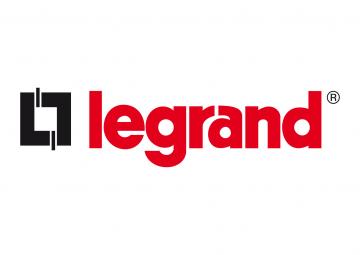At VERGE SF, Legrand announced it is sharing key energy savings resources that have been developed as part of a successful effort to significantly reduce energy intensity across its North American facilities. These resources can be used by manufacturing companies and other organizations to develop and implement energy and cost savings programs for their businesses.
The first energy savings resource, a 16-page Energy Management Handbook, is a straightforward tool to help companies take a practical and logical approach to launching an energy management program. The handbook draws on key learnings from Legrand’s efforts to reduce energy consumption. It outlines a four-step process: Making a Commitment, Assessing Your Current State of Energy Use, Creating an Action Plan, and Reporting and Evaluating Progress. The handbook is available for download at www.legrand.us/sustainability.
The second resource is a new Energy Project Evaluation Tool, an interactive spreadsheet that shows companies where to start on their energy savings journey. To explain the Energy Project Evaluation Tool, Legrand will offer Web-based learning modules.
Both energy savings resources are offered at no cost as part of Legrand’s ongoing commitment to share resources it is developing as it reduces energy intensity across its North American facilities.
“Legrand is working to make dramatic improvements in energy management across our North American sites – from office buildings to warehouses to factories," said Susan Rochford,Vice President of Energy Efficiency, Sustainability & Public Policy for Legrand North America. "At VERGE SF, I am sharing the story of our public commitment – as part of the Department of Energy’s Better Buildings, Better Plants Challenge – where in two short years, we achieved a 20.2 percent energy intensity reduction across our facilities.”
Added Legrand North America President and CEO John Selldorff, “The success we’ve witnessed in the last two years has stemmed not only from the implementation of energy projects, but from a holistic framework that includes initiatives aimed at engaging employees in energy savings, establishing visible energy goals and accountability to meet them, and launching a common company-wide approach to tracking, reporting, and analyzing energy use – this is our focus on people, processes, and technology. We’re committed to sharing our energy savings resources with other companies who may be starting or are in the middle of their sustainability journey.”
According to Joel Makower, Executive Editor of GreenBizGroup and host of the VERGE SF conference, “Legrand is taking a major step in freely sharing the resources it has developed, including its own best practices, with other organizations. This showcases the power of working together - across companies and sectors – to optimize everyone’s energy use. We’re excited to hear their success story and support them in sharing their tools with other companies around the world.”
Related Stories
Sustainability | Feb 26, 2024
GBBN's Inflation Reduction Act Calculator goes live
GBBN has publicly released its IRA Calculator, a tool that helps you understand funding opportunities in the IRA for sustainable design.
MFPRO+ News | Feb 15, 2024
Nine states pledge to transition to heat pumps for residential HVAC and water heating
Nine states have signed a joint agreement to accelerate the transition to residential building electrification by significantly expanding heat pump sales to meet heating, cooling, and water heating demand. The Memorandum of Understanding was signed by directors of environmental agencies from California, Colorado, Maine, Maryland, Massachusetts, New Jersey, New York, Oregon, and Rhode Island.
Codes | Feb 9, 2024
Illinois releases stretch energy code for building construction
Illinois is the latest jurisdiction to release a stretch energy code that provides standards for communities to mandate more efficient building construction. St. Louis, Mo., and a few states, including California, Colorado, and Massachusetts, currently have stretch codes in place.
Sustainability | Feb 7, 2024
9 states pledge to accelerate transition to clean residential buildings
States from coast to coast have signed a joint agreement to accelerate the transition to pollution-free residential buildings by significantly expanding heat pump sales to meet heating, cooling, and water heating demand in coming years.
Sustainability | Dec 22, 2023
WSP unveils scenario-planning online game
WSP has released a scenario-planning online game to help organizations achieve sustainable development goals while expanding awareness about climate change.
Sustainability | Nov 1, 2023
Researchers create building air leakage detection system using a camera in real time
Researchers at the U.S. Department of Energy’s Oak Ridge National Laboratory have developed a system that uses a camera to detect air leakage from buildings in real time.
Hotel Facilities | Sep 15, 2023
The next phase of sustainability in luxury hotels
The luxury hotel market has seen an increase in green-minded guests looking for opportunities to support businesses that are conscientious of the environment.
Metals | Sep 11, 2023
Best practices guide for air leakage testing for metal building systems released
The Metal Building Manufacturers Association (MBMA) released a new guidebook, Metal Building Systems - Best Practices to Comply with Whole-Building Air Leakage Testing Requirements.
Regulations | Aug 23, 2023
Gas industry drops legal challenge to heat pump requirement in Washington building code
Gas and construction industry groups recently moved to dismiss a lawsuit they had filed to block new Washington state building codes that require heat pumps in new residential and commercial construction. The lawsuit contended that the codes harm the industry groups’ business, interfere with consumer energy choice, and don’t comply with federal law.
Green | Aug 7, 2023
Rooftop photovoltaic panels credited with propelling solar energy output to record high
Solar provided a record-high 7.3% of U.S. electrical generation in May, “driven in large part by growth in ‘estimated’ small-scale (e.g., rooftop) solar PV whose output increased by 25.6% and accounted for nearly a third (31.9%) of total solar production,” according to a report by the U.S. Energy Information Administration.

















